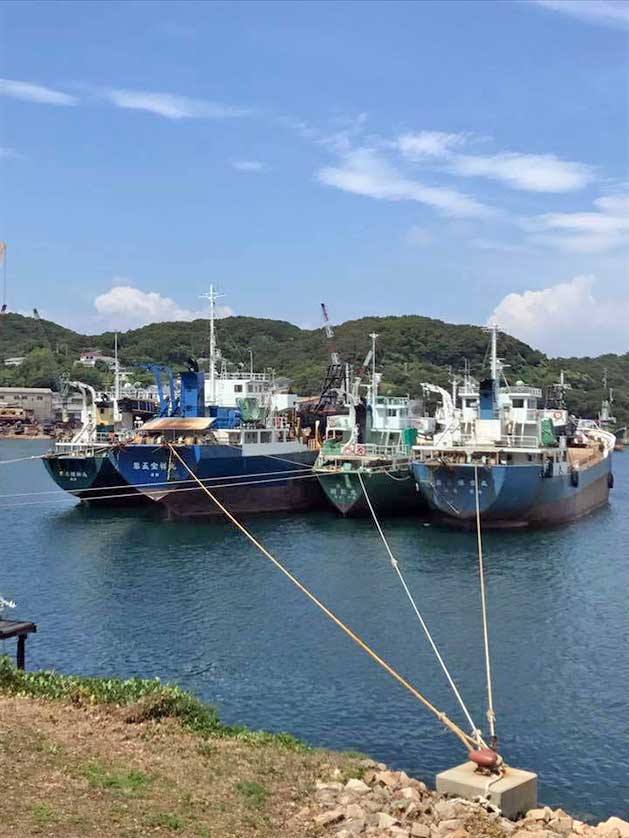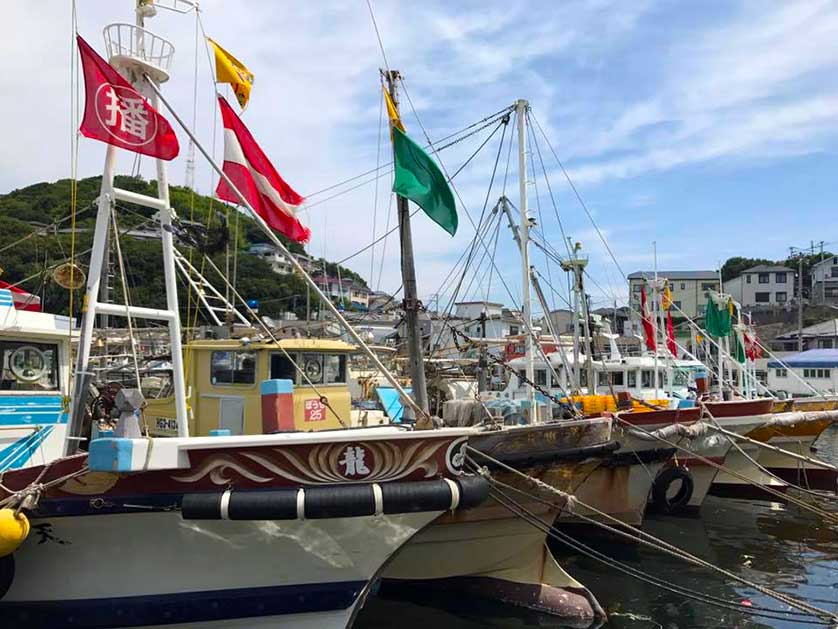Bozejima & Iejima
Knowing Tranquility Part X: Bozejima & Iejima 坊勢島 & 家島町
Edward J. Taylor
Ieshima in the Inland Sea is a group of 44 small islands off the coast of Himeji and Ako in Hyogo Prefecture, of which four are inhabited. Ieshima and Bozejima are the two largest islands with populations of about 4,000 inhabitants. Tangashima and Nishijima make up a quartet of islands closest to the Honshu coast. Fishing and quarrying are the main industries on the islands, which includes Shodoshima. Various islands in the group supplied stone for the construction of Osaka Castle.
The ferry's upper deck is out of an old film, with a wide-open space bare but for a few benches for the smokers. In those films, passengers would stand at the rails, holding a long streamer whose other end is held by someone standing on shore. Environmental consciousness has caught on with the Japanese, so those streamers are long gone.
But the sentiment remains, and as the boat pulls away, a group of middle-schoolers bound for a three-day school excursion wave farewell to their mothers whose own frantically waving hands look as if they are shoving us off.
I too stand at the rail, waving to no one, watching the boat free itself from the concrete breakwater that looks like the legs of a massive gray crab. Himeji Port is pretty typical as far as Japanese harbors go, overbuilt and industrial. But it is an interesting study in verticality, with the smokestacks and cranes, and even the lean grace of an egret standing on the jetty.

Fishing boats, Ieshima

Old boat on Bozejima
Bozejima 坊勢島
The Iejima Islands loom up gradually, forty-four of them, though only four are inhabited, and two of those just barely. In his The Inland Sea, Donald Richie does a bit of sleight of hand in claiming that Bozejima is uninhabited. Poetic license perhaps, in order to better frame his story of the girl Benten, who drowns herself in an act of filial piety. In fact the island has close to 4,000 residents, the most famous being the first, a Buddhist priest from Hiei-zan who washed up here in a storm and gave the island its name, bozu being a common term for monks.
I presume it will take me about an hour to walk a loop around the island. Leaving the harbor behind, I pass through the narrow labyrinthine lanes of the village until the buildings peter away. I am surprised at the sight of an old fishing junk floating past, before a backdrop of small scrub-covered islands rising like the curved backs of swimming bison.
Perhaps in keeping with the morals of its Buddhist roots, the residents are friendly and quick to offer a warm greeting. Even from the saddle. A trio passes on motor scooters, offering three bows. As usual, there are very few cars here, people preferring to navigate the compact confines on two motorized wheels. In a few cases, toddlers stand between the clenched thighs of their mothers, tiny hands on the dashboard, faces in the wind.
Come to think about it, there is a surprising amount of traffic, but I did choose to follow the island's main ring-road. Another loop sprawls up and around the thicker mountainous body to the south, but I will keep things simple today as the map shows that there is little up there worth seeing.
An overlook at the top promises one of the best sunsets in the region, but the sun is still high in the sky, and at the height of its thermodynamics.

Port on Bozejima

Seaside shrine, Bozejima
Paintings
The grounds of a middle-school wraps itself around the harbor, with sounds of basketball practice coming from the gym. Over the years, students have painted incrementally the low seawall out front, each grade adding a different set of images.
It appears to have begun back in the mid-80's with a representation of the Peanuts gang. The most recent incarnation is already 15 years old, an odd choice in copying ukiyo-e woodblock prints of famous kabuki actors from the Edo Period. The port is just over the wall, and one section has been covered to create a sort of community center, with chairs for the old timers to chat and smoke, as well as a space for kids to play.
I pass a nice section of swimming beach, enclosed and snug at one end of the harbor. Not far off is a small restaurant called Sun. Over some fried octopus and beer I attempt to chat with the proprietress, who is reserved at first, but soon takes comfort in my Japanese.
She asks if I think that island people are shy with strangers, and I tell her I have always thought the opposite. It is mountain folk who are nervous about the outsiders who penetrate their narrow valleys, historically being brigands or advancing armies.
Neither of these promised a positive outcome and naturally they'd be wary. Islanders however came to rely on news and trade goods from without, and would greatly welcome these visits. They appear to enjoy each other's company as well, for Bozejima is the only island in the Inland Sea with a growing population.

Quarry Island of Tangajima, on the way to Bozejima
Iejima (Ieshima) 家島町
I am only one of three passengers on my next ship, neither of whom seems to notice me, despite our being on what is little bigger that a speedboat. We whisk across to Iejima in just ten minutes. The port is small and free of houses, with a massive freighter pulled on shore to undergo repairs.
A number of high schoolers have walked over the hill from town, and in front of a small Jizo hut, a pair of aunties sits gossiping in the shade. Noticing me pass by, they offer me a bag of sweets, wrapped up nicely for Jizo-bon, an event traditionally held in August for the local children.
Thus laden, I sweat up and over the hill to the island's leeside, where most of the islanders live. Along the way, I come across a trio of workmen doing something suspect to the road. Nearby, an old man watches from the shade of a large tree, having found his entertainment for the day. Just beyond are the neighboring high school and middle schools, large concrete monsters sitting atop bare open grounds.
I've written before that schools are usually the most interesting building on these islands, but not in this case. Their looks are simultaneously modern and "just-past-their-sale-date," a comment that applies equally to the houses. We're not far from the mainland here. A couple of them do have a unique flourish, namely one that has an unusual three-story spire. Seeing it set among the crowd of houses on the cramped hillside, for a brief moment, I am in Sicily.
Ancient Emperor
The name Iejima was given by an ancient emperor who had found the harbor as safe as one's own home. The current built up look is more homely than homey, but I quickly learn that the hospitality of the residents more than make up for it. Two fishmongers greet me as I pass, both cooling themselves on shaved ice.
Now into the full heat of afternoon, the second woman looks to be suffering a bit, nearly as melted as the ice in the styrofoam boxes that had kept her fish fresh a few hours before. A conger eel still has traces of life, but not so the two fugu, one floating on its side, the other belly-up, the flesh as nearly as white as the styrofoam itself.
Here, as on Bozejima, Ritchie leaves us with a mystery. He offers up a good number of pages in his book to a local shrine, which I presume is the Ieshima shrine across the bay.
His description is pretty apt, yet he discusses climbing up a set of steps, which aren't actually there. I guess that this too is a poetic attempt to introduce Shinto to the reader, coming as this visit does so early in the book. At that point in the narrative, the islands are still metaphoric to him, still lofty in his imagination. He won't get pulled down until he begins to engage with the earthiness of the Inland Sea's residents themselves.
Jizo
I wonder if his description was of the island's castle mound, so I wander the narrow lanes between houses, which also climb in that direction. Along the way, is another Jizo hut and a group of attendant aunties. I join them in the shade, and accept their offer of cold tea and more snacks. They must not get many foreigners here, and are probably more intrigued why a foreign resident of Japan would chose this particular island for a day-trip. We chat awhile, and when I again thank them for the snacks, telling them that I'll give them to my daughter, they in turn thank me for having a child in the first place. Japan's falling population seems to worry the older generation far more than it does the politicians.
My boat pulls away, drifting slowly to the opposite end of the paired harbor towns. Rusty hulks line both sides, matching the darkened metal of the structures on shore. Most of these ships have open decks with attendant cranes, and it dawns on me that it is from this point that they sail to the neighboring islands of Nishijima and Tangajima, both of which are nearly uninhabited and serve mainly as quarries, sacrificed to the nation's concrete addiction. They have been carved up in a way that is oddly beautiful, and from the shifting point of perspective of the boat, resemble either the Seven Sisters of Sussex, or Yosemite Valley.
But the beauty is accompanied by a certain sorrow. The abused, forlorn look to these islands is enhanced by the sky darkening to the west. I'd gotten lucky with the weather despite the humidity, and I had nearly canceled this trip after looking at the forecast. But the weather had held, and now, as it began to turn, I strained to look into it, at the hidden islands to come.
Access - Getting To Bozejima & Iejima
Ieshima and Bozejima are reached by ferry from Himeji Port.
The journey takes about 20 minutes from Himeji Port to Ieshima.
Himeji connects to the big cities on the Pacific Coast on the Sanyo shinkansen. From Himeji Station take a Himeji city bus #37 to Himeji Port (姫路港行き) about 20 minutes or ride a taxi.
Accommodation
See here for hotels and guest houses on the Iejima islands: http://h-ieshima.jp/hotel.html (in Japanese). If you wish for us to reserve accommodation for you (for a small fee) please contact us.
See here for a full listing of hotels and guest houses on Shikoku.
See here for hotels in Himeji.
About the Author
Based in Kyoto, Edward's work has appeared in a variety of print and online publications. Co-editor of the Deep Kyoto Walk anthology, he is currently at work on a series of books about walking Japan's ancient highways. Edward is the author of the blog notesfromthenog.blogspot.jp
Books on Japan Travel
Bozejima & Iejima, in Hyogo Prefecture, are two islands in the Inland Sea off the coast of Himeji. Fishing and quarrying are the main industries on the islands.









